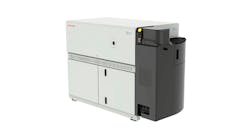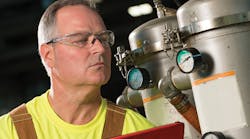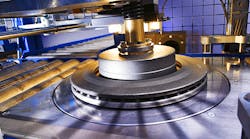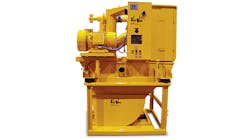As you read this essay, your metalcasting operation may be failing to comply with new OSHA standards for crystalline silica. OSHA Standard 29 CFR 1910.1053 took effect on June 23, 2016, and focuses on respirable crystalline silica (quartz, cristobalite, tridymite). It sets extremely stringent guidelines for businesses that work with those materials, including foundries, of course, but also glass factories, brick factories, and more. A separate standard was approved and instituted to address respirable crystalline silica at construction sites.
Without question, OSHA’s new standard will force manufacturers to do an significant amount of preparation work in a comparatively short period of time. The question that many companies are asking is, “Is this even necessary?”
While the cleaning requirements can be met easily using an industrial vacuum system, other parts of the required preparation are going to be taxing and time-consuming to foundries and other manufacturers
According to a recent presentation by Tom Slavin, of Slavin OSH Group LLC, and Stephanie Salmon of AFS, the new standard would limit the amount of respirable silica to the volume of a small sugar packet within a full football stadium. There is some doubt as to whether such an exacting approach to silica suppression is even possible.
What must be done — OSHA is allowing non-construction businesses two years to meet these new silica standards. In the months ahead, foundries and other businesses that must achieve compliance by June 2018 need to consider all of the following:
• Exposure levels must be assessed. First, all businesses in impacted industries must determine what the exposure level is for every single employee. Slavin and Salmon noted that this might be done with exposure mapping and real-time instruments that will identify sources and the percentages of quartz. Exposure assessment means that monitoring must be implemented for every project, every shift, and each activity that employees are assigned to complete.
• Silica measurement. Determining how much silica must be cleaned up in your plant is a challenge unto itself. According to Slavin and Salmon, it can take up to four hours just to gather enough quartz for an analysis.
• Educate all employees in detail. Along with learning how to accurately track and control exposure levels and silica measurement, companies also need to educate all employees regarding engineering and work practice controls, what to do in case exposure increases, how to create restricted areas, and what exactly that means, and more.
• Improve analysis of employee health records. Businesses now must keep even closer tabs on incidents of silicosis and/or lung cancer. These occurrences must be tracked along with exposure levels to see if there is a correlation.
Along with all of these changes, manufacturers need to change even the way they clean. Until now, factory workers have been able to use shovels, brooms, or air hoses to clean work areas. The new standard stipulates that silica cleanup must be contained. Shoveling and sweeping are no longer options.
Will it be worth it? — On top of all of the work required to meet the new OSHA standard, the impacted industries are questioning whether the new aggressive guidelines are even necessary. The American Foundry Society even filed an official challenge against the new standard. Additional petitions were filed, according to Slavin and Salmon, by the U.S. Chamber of Commerce, the construction consortium, and the National Stone, Sand & Gravel Association.
The American Brick Association also challenged the ruling, stating that current silica-caused illnesses are so infrequent that changing the guidelines will not make a measurable difference.
Businesses operating in the impacted industries, in other words, feel that they are being asked to introduce several new processes into their workplaces, potentially disrupting productivity, with very little proof that there is a reason to do so.
Cleaning Will Never Be The Same
Even if OSHA backs down a bit from this new standard (a highly unlikely development), the fact is that the new cleaning regulations will not change. The days of compressed air, shovels, and brooms are over. No matter what else may change, this is one development that industries will definitely have to adjust to over the next two years. So, the question now is, what is a viable solution to the new cleaning problem?
In terms of cost, safety, effectiveness, and efficiency, the best answer now is an industrial vacuum system. In particular, the manufacturers should recognize the effectiveness of an industrial vacuum system that vents cleaned air back into the atmosphere, versus systems that vent polluted air outside of the plant. Note that once air leaves the building, the EPA can join OSHA in regulating the operation.
It is also important to make sure that the system will be easy to use. Employees already have to make significant adjustments to their operating practices”. Adding more detail or stress to the situation will not help achieve anyone’s near-term or long-term goals.
Several manufacturers make reliable industrial vacuum systems. When searching for the perfect system, one of the most important things to determine is the air-to-cloth ratio. This detail will signify how effective the system may be at pulling particulates out of the air.
Also, determine what material the filters are made of and how tightly pleated those filters are. Gore-Tex filters can capture the smallest particulates, while other materials may not be able to work at the same level of precision. Moreover, if the filter is tightly pleated it will not work as effectively as a filter with wider pleats.
Make sure the system you select offers important safety features like a broken-bag safety shutdown, low blower oil safety shutdown, and high vacuum pump temperature safety shutdown.
Investing in such a wholesale change to an operation will be intimidating, of course, but there are some positive aspects to weigh, too. Leasing options are available for these types of systems, including some as low as $750/month. Additionally, even if these cleaning changes were not mandated, an industrial vacuum system would save plant operators a lot of time and a lot of labor. Where previously one or two people would be responsible for sweeping and the shoveling, an industrial vacuum system connected to a central manifold system cleans continuously with very little effort on the part of your staff.
If not silica, then what? — Suppose OSHA were to announce, “Oh, you’re right, silica isn’t such a big deal. Let’s roll back the standard.” Would you still have to worry about changing how you run your plant? The answer is yes, at least eventually. While silica is the threat being dealt with today, any number of other issues could emerge in the years to come. New standards will be issued to deal with other types of particulates that will require the same types of changes businesses face now. Future standards may be even more aggressive than the new silica standards.
This is not a reason to give up. Rather, these silica cleanup changes will pave the way for operations to become more agile in the face of government regulations. Moreover, switching to an industrial vacuum system brings benefits beyond those that any new standards may require. What can outweigh a cleaner, safer working environment with little effort from the workforce?
A lot may change for foundries in the coming months, and some things may stay the same for a while yet. One thing that certainly will change is how foundries are cleaned moving forward. Is your plant ready?
Dan Coley is the president Hi-Vac Corporation, a developer of systems for maintaining infrastructure, improving air quality, and non-destructively excavating, recycling, cleaning, and maintaining the environment. Contact him at [email protected]










